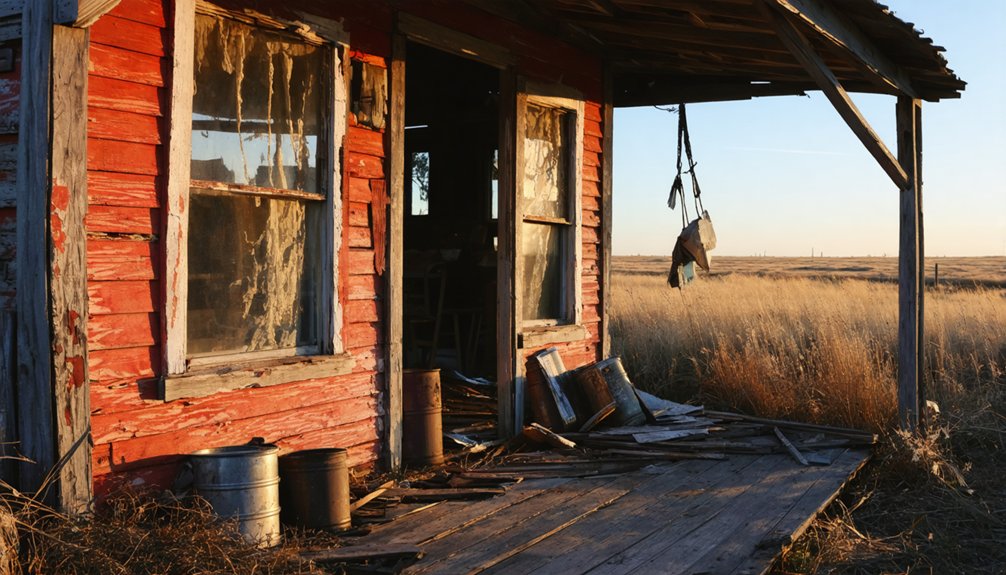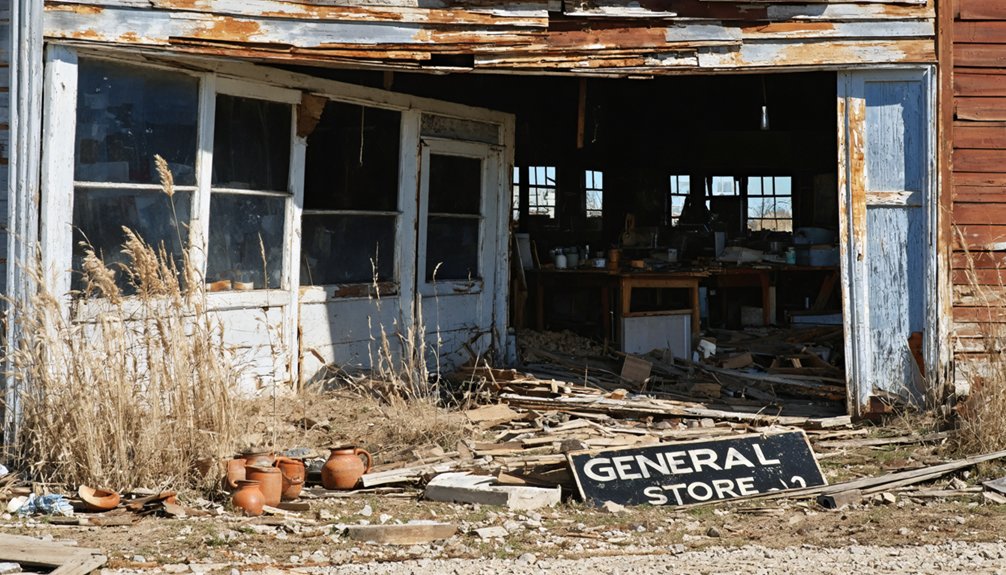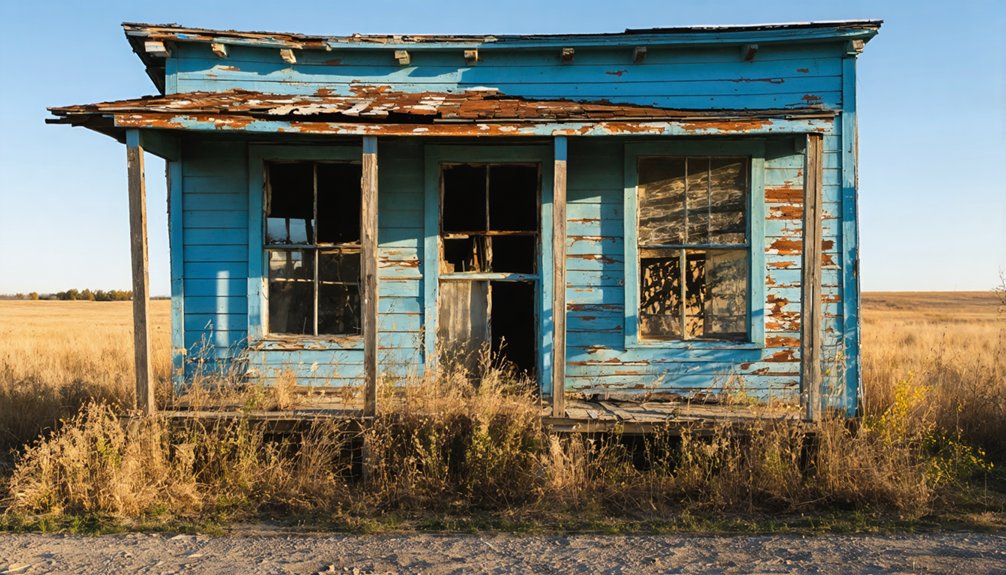You’ll find Tigerville 4.5 miles northwest of Hill City, South Dakota, where gold discoveries in 1878 transformed this Black Hills crossroads into a thriving boomtown. Named after the Bengal Tiger Mine, the settlement grew to 500 residents, featuring saloons, stores, and a post office. Though the mines proved disappointing by 1885, leading to its abandonment, Tigerville’s remaining foundations and artifacts tell a rich story of frontier life, mining dreams, and community spirit.
Key Takeaways
- Tigerville emerged as a Black Hills boomtown in 1878 following gold discoveries at King Solomon Mine, reaching 500 residents at its peak.
- Located 4.5 miles northwest of Hill City, South Dakota, at 5,485 feet elevation in the Black Hills region.
- The town featured three saloons, two stores, a post office, and a blacksmith shop during its brief seven-year existence.
- Failed mineral yields at the Bengal Tiger Mine led to the town’s abandonment by 1885, becoming one of hundreds of Black Hills ghost towns.
- Today, only foundation traces remain at the site, though the area is accessible for historical exploration and tourism.
The Rise of a Black Hills Boomtown
When gold was discovered in the King Solomon Mine area in 1878, Tigerville quickly emerged as a strategic Black Hills boomtown at the crossroads of major routes connecting Cheyenne, Custer, and Deadwood.
Named after the nearby Bengal Tiger Mine, the town’s mining expectations soared as prospectors and merchants flocked to stake their claims in the region’s rich gold and quartz deposits.
You’d have found a bustling transient economy with essential infrastructure including a post office, two stores, three saloons, a blacksmith shop, and a school.
The town’s population swelled to 200 by 1880, reaching 500 at its peak.
Like many Black Hills ghost towns, Tigerville’s remnants today include only traces of foundations and memories of its former glory.
As part of the broader Black Hills gold rush, Tigerville’s strategic location and early infrastructure made it a crucial hub for travelers, traders, and miners seeking their fortunes in the untamed Dakota Territory.
Life in 1878 Tigerville
Three distinct social groups shaped daily life in 1878 Tigerville: the permanent residents who ran essential businesses, the steady stream of travelers passing through on major routes, and the transient miners seeking their fortunes.
You’d find family dynamics centered around the town’s core institutions – two general stores, three saloons, and a schoolhouse where teachers Nellie Thomas and Annie Tallent faced educational challenges with frontier children.
Local establishments served both settled families and the constant flow of prospectors, gamblers, and freight haulers moving between Cheyenne, Custer, and Deadwood.
While the Bengal Tiger Mine proved disappointing, Tigerville’s position at key crossroads kept it bustling.
The town’s political influence was notable, sending six delegates to Republican Party meetings, showing the community’s determination to shape its destiny.
Mining and Economic Activities
Although the Bengal Tiger Mine never fulfilled its promise, Tigerville’s mining economy flourished around the King Solomon Mine‘s rich gold and quartz deposits in 1878.
You’d have found a bustling community of nearly 500 residents at its peak, with mining techniques focused on extracting both gold and valuable quartz byproducts.
The town’s economic backbone wasn’t just about mining – you could’ve visited any of three saloons, two stores, or the blacksmith shop. A strategic horse and carriage barn served travelers on the Cheyenne-Custer-Deadwood route.
Despite early success, economic challenges emerged by 1885 when the mines closed. Unlike the region’s industrial-scale operations in Lead and Deadwood, Tigerville’s mining ventures proved short-lived, causing miners to either move away or switch to ranching for survival. This contrasted sharply with operations like the Homestake Mine’s success, which produced nearly 40 million ounces of gold over its 125-year history.
Geographic Features and Location
Nestled in South Dakota’s picturesque Black Hills region, Tigerville sits approximately 4.5 miles northwest of Hill City at an elevation of 5,485 feet.
You’ll find this ghost town in Pennington County, where roads intersect leading to Deerfield Lake and Rochford, making it easily accessible for exploration.
The area’s geographic diversity showcases the rugged beauty of the Black Hills mountain range, with dense forests teeming with wildlife and stunning vistas at every turn.
Natural resources once drew settlers here, and today you can experience the same untamed landscapes they encountered.
While exploring Tigerville, you’re surrounded by scenic drives that connect to nearby attractions, including Deerfield Lake’s recreational opportunities and various historical sites that dot the mountainous terrain. Similar to its namesake in South Carolina, this region features rolling hills and pastoral landscapes.
The town flourished briefly from 1878 to 1885 before becoming one of the many abandoned mining settlements in the region.
Daily Life and Social Structure
In Tigerville’s heyday of the 1870s and early 1880s, you’d find the bustling community gathered at local saloons and general stores, which served as the town’s primary social hubs where miners could swap stories after their grueling shifts.
Living conditions were basic, with most residents occupying hastily built cabins and tents clustered around the Bengal Tiger and Lucky Tiger mining claims. Like ghost towns nearby, Tigerville offered a glimpse into South Dakota’s rich mining heritage through its abandoned buildings and quiet streets.
The town’s businesses, including boarding houses and supply shops, operated on feast-or-famine cycles that directly mirrored the successes and failures of the local mining operations.
Community Gathering Places
Like many frontier settlements of its time, Tigerville maintained several key gathering places where residents could socialize and conduct daily business.
You’d find locals congregating at the general store, which served as a central hub for trading goods and sharing news. Saloons offered another popular venue where miners and townspeople could unwind after long workdays, though specific details about Tigerville’s establishments are limited.
Community events likely took place in whatever buildings were available – possibly a schoolhouse or church, though historical records don’t confirm their existence.
The town’s gathering traditions probably centered around informal meetups at these locations, where residents could discuss community matters, resolve conflicts, and maintain social bonds.
Given Tigerville’s small size, these spaces played a vital role in fostering the close-knit relationships needed for frontier survival.
Mining Camp Conditions
While Tigerville’s daily life centered on the demanding work of gold and quartz mining, the camp’s social structure developed to support roughly 500 residents at its peak.
You’d have found miners working long hours in small-scale operations, with no major mining companies controlling the work. The mining camp conditions were basic but functional – miners could visit the blacksmith for tool repairs, shop at two general stores for supplies, and unwind at three saloons after their grueling shifts.
Despite the labor challenges, you’d have seen a surprisingly stable community with a schoolhouse for children and essential services like a post office and horse barn.
The social hierarchy remained relatively fluid, letting miners, merchants, and service providers move up the economic ladder through their own initiative.
Local Business Operations
Beyond the mining operations that defined Tigerville’s economy, you’d have found a surprisingly diverse network of businesses serving the community’s daily needs.
Merchant ventures included general stores stocking essential supplies from food to mining tools, while the town’s saloon culture created essential social spaces where miners could unwind after their shifts.
You’d have encountered busy blacksmith shops maintaining critical mining equipment, and a post office that kept Tigerville connected to the outside world.
Local entrepreneurs also operated boarding houses to shelter the town’s transient workforce. These businesses formed an interconnected web of commerce that sustained daily life in the settlement.
While the infrastructure remained basic with dirt roads and wooden buildings, these establishments helped transform Tigerville from a mere mining camp into a functioning community.
The Mysterious Decline

Despite its promising start as a bustling mining settlement of 500 residents, Tigerville’s decline began when the Bengal Tiger Mine failed to yield the expected mineral wealth.
Without a sustainable economic foundation, the town’s population rapidly dwindled as miners and their families sought opportunities elsewhere. By 1885, this once-vibrant community had largely emptied through population migration to other mining towns and nearby ranches.
You’ll find that Tigerville’s story mirrors many Black Hills settlements of that era. The town’s infrastructure, including its post office, stores, and saloons, couldn’t survive without mining revenue.
Finding the Lost Settlement
Today, finding the exact location of Tigerville presents a unique challenge for historians and ghost town enthusiasts.
You’ll need to piece together fragments from multiple sources, including oral histories, old maps, and geological surveys to track down this elusive Black Hills settlement that vanished by 1885.
Your ghost town exploration will require careful research and methodical investigation, considering these key factors:
- The town’s connection to the Bengal Tiger Mine and Lucky Tiger claims, though their exact locations remain unverified.
- Historical documents and USGS surveys that might reveal previously unrecorded details about the settlement’s position.
- Physical evidence like foundations or debris fields, though these are scarce due to nature’s reclamation of the site.
The 5,485-foot elevation marker serves as your primary geographic reference point in Pennington County’s challenging terrain.
Archaeological Discoveries

While systematic excavations at Tigerville remain limited, archaeological discoveries have yielded fascinating insights into frontier life through carefully preserved artifacts and features.
Archaeological methods like structured excavation around collapsed buildings and privies have revealed how settlers used different spaces within the town.
You’ll find evidence of daily life in recovered domestic items like broken dishes and furniture, while specialized artifacts tell stories of leisure and cultural diversity.
Opium pipes, gambling pieces, and Chinese gaming items suggest a multicultural community.
The archaeological methods used mirror those of other Black Hills mining settlements, particularly Deadwood’s Chinatown.
Through elemental and stylistic analysis of artifacts, you can trace the trade networks that connected Tigerville to other mining communities across South Dakota’s frontier landscape.
Historical Impact on South Dakota
Although Tigerville’s existence lasted merely seven years from 1878 to 1885, it exemplifies the rapid boom-and-bust cycle that shaped South Dakota’s early mining history.
While Tigerville’s legacy might seem minimal, it’s part of a broader narrative that tells the story of human determination and the pursuit of fortune in the Black Hills.
You’ll find Tigerville’s historical impact reflected in these key aspects:
- It’s one of 600-1,200 ghost towns that showcase the region’s mining nostalgia.
- It represents the transient nature of frontier settlements during the gold rush era.
- It serves as an indication of the freedom-seeking pioneers who shaped South Dakota’s identity.
While no significant structures remain, Tigerville’s story continues to contribute to our understanding of the state’s dynamic settlement patterns and mining heritage.
Frequently Asked Questions
Why Was the Town Named Tigerville?
You’ll find Tigerville’s origins stem from the Bengal Tiger Mine nearby, though some say it’s named for Lucky Tiger claims. Either way, the town’s significance reflected the mining boom’s optimistic spirit.
Were There Any Major Conflicts or Crimes Reported in Tigerville?
You won’t find any documented Tigerville crimes or major conflicts in historical records. The town operated from 1878-1885 without evidence of violence, police presence, or significant disputes requiring formal intervention.
What Happened to the Buildings and Materials After Abandonment?
You’ll find most buildings fell to natural decay, while locals salvaged valuable materials for reuse elsewhere. The wooden structures collapsed, metals were scavenged, and only stone foundations mostly remained in place.
Did Any Notable Personalities or Historical Figures Visit Tigerville?
You won’t find records of any famous residents or historical visitors in Tigerville’s brief existence from 1878-1885. The mining town’s isolated location and short lifespan limited its notable personalities.
Were There Any Significant Weather Events That Impacted the Town?
You’ll find records show devastating weather patterns struck the region, including the brutal 1880-1881 winter blizzards and 1889 prairie fires, though specific natural disasters in Tigerville aren’t directly documented.
References
- https://www.powderhouselodge.com/black-hills-attractions/fun-attractions/ghost-towns-of-western-south-dakota/
- https://www.sdhspress.com/journal/south-dakota-history-2-2/some-black-hills-ghost-towns-and-their-origins/vol-02-no-2-some-black-hills-ghost-towns-and-their-origins.pdf
- https://www.sdpb.org/rural-life-and-history/2023-08-21/some-black-hills-ghost-towns-and-their-origins
- https://kids.kiddle.co/Tigerville
- https://freepages.history.rootsweb.com/~gtusa/usa/sd/blackhills.htm
- https://pastmaps.com/explore/us/south-dakota/pennington-county/tigerville/hiking-exploration
- https://en.wikipedia.org/wiki/List_of_ghost_towns_in_South_Dakota
- https://www.blackhillshikingbikingandmore.com/old-mining-ghost-towns
- https://www.sdhspress.com/journal/south-dakota-history-2-3/the-boom-and-bust-of-central-city/vol-02-no-3-the-boom-and-bust-of-central-city.pdf
- https://www.sdhspress.com/journal/south-dakota-history-11-1/booming-the-black-hills/vol-11-no-1-booming-the-black-hills.pdf



